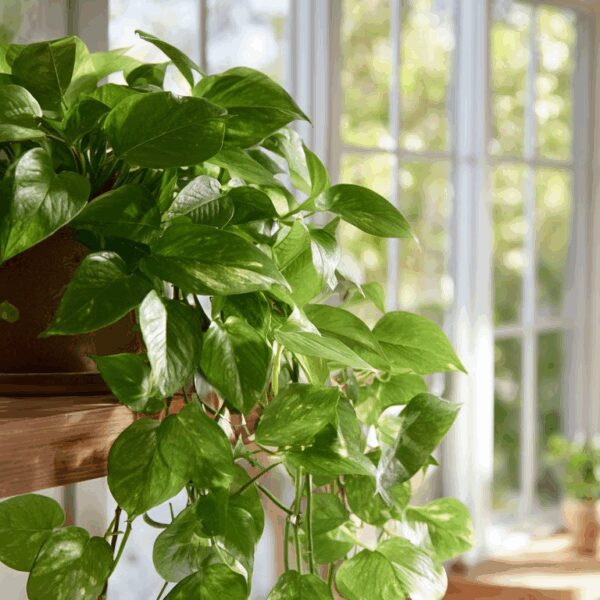If you’re on the hunt for a low-maintenance beauty that works double duty as a stunning decor piece and an air purifier, the snake plant is calling your name. Trust me, with its sleek leaves and knack for filtering out toxins, this little gem is about to become your bedroom’s best friend!
🌱 Green Thumb Essentials in 4 Points:
- Air Quality Boost: Your snake plant is a natural air purifier! 🌬️ It filters out nasty toxins like formaldehyde and benzene while you snooze, making your bedroom a healthier haven.
- Low-Maintenance Love: Keep it simple! These plants thrive on neglect. Water every 2-3 weeks in spring/summer, and just once a month in winter. Overwatering? A big no-no! 🚫💧
- Light, Light, Light: Snake plants prefer indirect sunlight but can handle low light. If it starts stretching for the window, it’s time to reposition! ☀️✨
- Pest Patrol: Even tough plants need a little TLC. Check for mealybugs—just dab them with alcohol on a cotton swab. Easy peasy! 🐞🧼
Why the Snake Plant is Your Bedroom’s Best Friend
So, you’ve got a snake plant (Sansevieria trifasciata), and you’re wondering why it’s often hailed as one of the best air purifiers around. Well, let me tell you, this tough little plant isn’t just easy on the eyes; it’s also a powerhouse when it comes to improving your indoor air quality. As we cozy up for fall in October 2025, there’s no better time to explore how this beauty can make your bedroom feel fresher and more inviting.
How It Cleans the Air
Here’s the magic: snake plants are known for their ability to filter out toxins like formaldehyde, benzene, and xylene. These chemicals can be found in things like cleaning products, furniture, and even some types of paint. When you breathe them in over time, they can cause headaches or fatigue—definitely not what you want when you’re trying to relax after a long day. The snake plant absorbs these toxins while releasing oxygen at night, which is pretty unique for a houseplant. Most plants only do this during the day.
The NASA Clean Air Study, which looked into air-purifying plants back in the ’80s, highlighted snake plants as one of the top performers. So if you’re looking for a natural way to spruce up your air quality while you sleep, this plant is a stellar choice.
Perfect Conditions for Your Snake Plant
Now that you’re sold on having a snake plant in your bedroom, let’s talk about how to keep it thriving. First things first: these plants are incredibly low-maintenance but do have some preferences.
5 Thriving Houseplants That Don’t Need a Sunny Window
Light Requirements: Snake plants love indirect sunlight but can survive in low light too. If your bedroom faces north or has limited light due to trees outside, don’t sweat it! Just keep an eye on its growth; if it starts reaching for light or getting leggy, move it closer to a window with filtered light.
Watering: Here’s where many folks go wrong: snake plants prefer to dry out between waterings. In fact, overwatering is one of the quickest ways to kill them! During the growing season (spring and summer), give them a drink every two to three weeks. In fall and winter, scale back even more—once a month is usually plenty.
Potting and Soil Matters
Choosing the right pot and soil can make all the difference for your snake plant’s health.
Pots: Make sure your pot has drainage holes. This prevents water from sitting at the bottom—something our resilient little friend absolutely hates! A terra cotta pot works wonders because it allows moisture to escape through its porous walls.
Soil Type: Use a well-draining potting mix. You can find specialty succulent mixes at places like Home Depot or Lowe’s that work perfectly for snake plants. If you want to DIY, just mix regular potting soil with sand or perlite for added drainage.
Pest Patrol: Keeping Your Snake Plant Safe
Even though snake plants are pretty tough cookies, they’re not completely pest-proof. You might occasionally spot mealybugs or spider mites. But don’t worry! A simple solution is often within reach.
If you notice white cottony spots (hello mealybugs), dab them with a cotton swab dipped in rubbing alcohol—it’ll zap those pests without harming your plant. Regularly wiping down leaves with a damp cloth not only keeps those pesky bugs away but also promotes healthy growth.
The Seasonal Shift: Fall Care Tips
As we move into October and cooler weather settles in across much of the U.S., it’s crucial to adjust care routines slightly for your snake plant.
Since temperatures are dropping at night, ensure your plant isn’t sitting next to drafty windows or heating vents that could stress it out. Also, cut back on watering as mentioned earlier; they’ll need even less moisture now that they’re slowing down their growth for winter.
This fall season is also perfect for taking cuttings from healthy snake plants if you’re looking to propagate! Just snip off a healthy leaf close to its base and allow it to callous over before placing it in moist soil; soon enough, you’ll have new little friends sprouting up!
Your snake plant isn’t just another pretty face; it’s an essential member of your bedroom that works tirelessly while you sleep. So grab yours if you haven’t already! With just a bit of love and attention, you’ll enjoy cleaner air and a touch of nature right inside your home this autumn.







